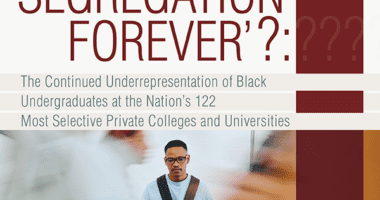Dispelling Myths About ‘Tough Love’
UPDATED
Nearly 300 positive and negative comments came into The New York Times editorial page earlier this week after it favorably discussed Ed Trust’s new report, Tough Love: Bottom-Line Quality Standards for Colleges. We’ve been encouraged by the positive feedback we’ve received. But we decided to pull out the most common negative comments and offer responses in an effort to further the discussion on accountability in higher education. We welcome a continued dialogue.
1. The problem with low graduation rates currently is poor preparation among incoming students. The whole “college for all” mantra is luring students who are not cut out for college.
Yes, preparation matters: In general, institutions serving better-prepared students have higher completion rates. However, similar colleges serving the exact same type of students can have vastly different success outcomes, suggesting what institutions do matters, too. The “college is only for some” argument distracts us from the urgent need to help more students earn college degrees now.
Take Florida State University and Louisiana State University. In 2011, both research universities enrolled similarly prepared students (median SAT of 1165-1185) from diverse backgrounds, and both were considered a “Very Competitive” college by Barron’s. Yet while these two colleges are peers, their graduation rates are very different: 74 percent at FSU and 60 percent at LSU.
Likewise, these differences exist among less selective colleges like Texas Southern University and North Carolina Central. Both enroll high populations of low-income students and students of color (80 percent and 90 percent, respectively), and enroll students with a median SAT in the 800s. The 2011 graduation rate at Texas Southern was extraordinarily low — 12 percent. Yet NC Central graduated students at more than three times that rate: 38 percent.
2. Setting a minimum graduation rate bar will encourage colleges to raise their admission standards, restrict access to less-prepared incoming students, and enroll more well-prepared students.
Most colleges are already as selective as they dare be, while still maintaining their enrollment targets. Almost nothing the federal government can do will affect that almost inexorable drive. Regardless, low-performing colleges don’t need to change their student mix in order to achieve better results; they need to change how they support those students once they arrive.
Since nearly 9 out of 10 colleges with six-year graduation rates below 15 percent fall in the bottom of their peer group, it is clear there are other institutions enrolling the exact same kinds of students and graduating them at much higher rates.
3. Low-resourced K-12 school districts frequently educate students who are less prepared for college — which affects Pell enrollment rates, especially in highly selective colleges. To enroll more low-income students, these colleges would have to “dumb down” their admission standards.
Certainly, the inequities in the K-12 public school system need to be addressed. But that doesn’t mean the higher education system is helpless to act either.
Our analysis of ACT data show that 20 percent of students with top scores come from low-income families. Clearly, there are plenty of talented, low-income students for highly selective schools to educate without “dumbing down” standards. Colleges just have to make it a priority to recruit, admit, enroll, and make affordable an education to students from low-income families and accordingly commit to a truly diverse student body.
4. Many students have life circumstances that force them to drop out. Colleges cannot control any of these life events and shouldn’t be held responsible.
Certainly, students bear some significant responsibility for persisting, even when facing challenging academic standards.
But it turns out that institutional practices can also get in the way of student success. Some institutions don’t offer enough sections of critical courses, delaying students on their path to a degree. Weak advising can force students to guess at necessary courses, wasting valuable time. Poorly chosen budget cuts can also make colleges hire part-time faculty who are often left unsupervised to teach critical introductory and remedial courses with large negative effects on student success.
We’ve seen scores of colleges improve graduation rates with everything from added resources for students to no- or low-cost changes to student services and academic departments. Salish Kootenai College, for example, which Secretary Arne Duncan visited this month, boosted its graduation rates by revamping their remedial education coursework, creating a new academic department, and providing additional financial and academic support to struggling students. As Stacey Sherwin, the director of institutional effectiveness, said, “There’s a tendency to think that the student is the problem. We found that a lot of times, it was the institution that was the problem.”
5. Setting a minimum bar on graduation rates will lead to a “race to the bottom” in academic standards, which would deflate the value of a college degree.
Our experience studying institutions that have vastly improved their levels of student success indicate the key is to raise standards, not lower them. It’s certainly theoretically possible for colleges to dilute their degree-granting standards and graduate students who don’t exhibit the knowledge and skills warranting a degree. That’s why we propose the third metric in our accountability system: student loan repayment rates (or in the interim, cohort default rates). All three metrics, in tandem, are critical to the overall accountability proposal.
We’ll cover several more common arguments Monday and again look forward to continued dialogue.
[starbox id=none]









